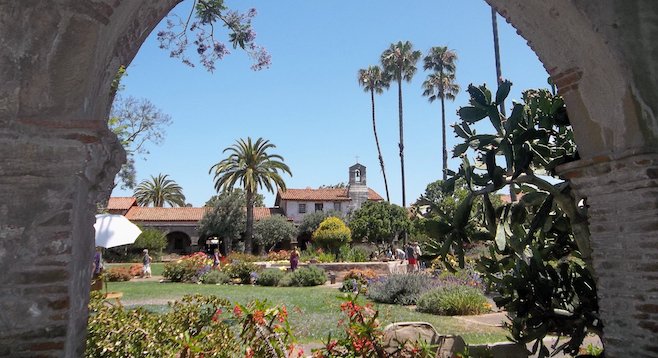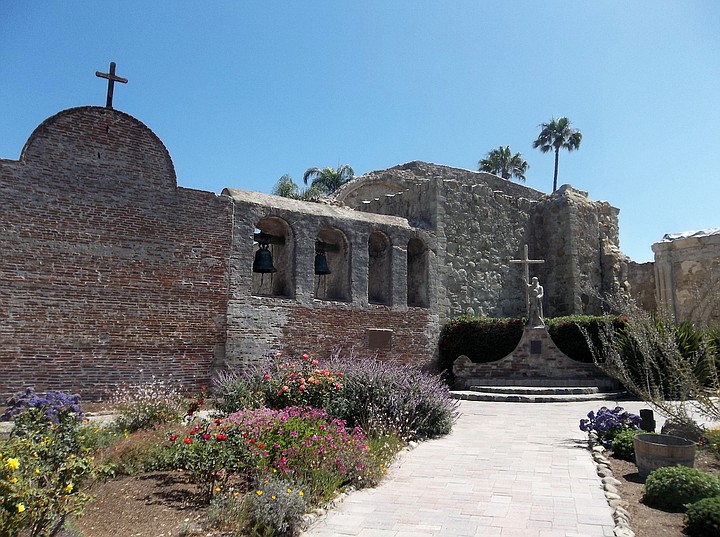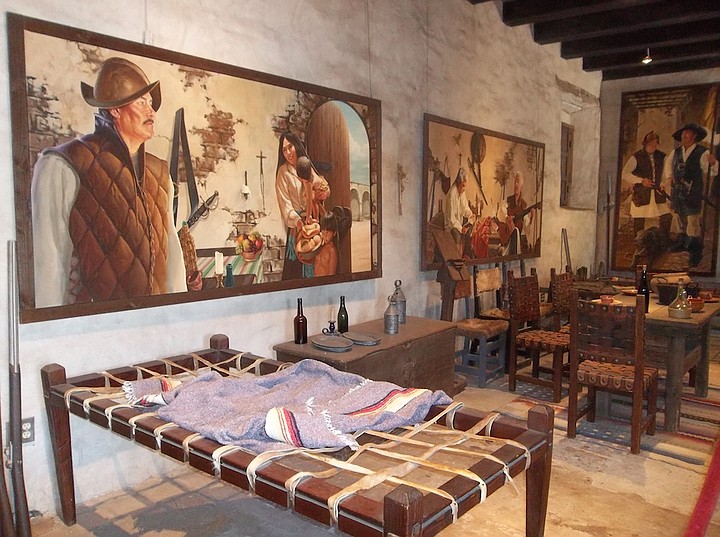 Facebook
Facebook
 X
X
 Instagram
Instagram
 TikTok
TikTok
 Youtube
Youtube

Just 61 miles north of San Diego up the 5 Freeway, San Juan Capistrano is one of the truly historic sites of Southern California.
The town is probably best known for the swallows that return every year from Argentina. Since 2009, however, most of the swallows have not gone to Capistrano, but Chino Hills to the north. It’s believed that the restoration of the Mission has led to a decline of the swallows here. There is, nevertheless, a street fair and parade honoring the return of the swallows every March 19.
The Mission San Juan Capistrano, constructed by Father Serra in 1776, is perhaps the most well-known and historically interesting mission in the state. It was the largest structure built by the Spanish in California and is considered the “Jewel of the Missions” for its beauty.

The Mission grounds are beautifully landscaped. The courtyard is particularly striking with its flower gardens and large central fountain; attractive colonnades provide shady viewpoints. The whistles of the Amtrak Surfliner trains and the Mission bells become familiar sounds to those who stroll the grounds.
It is said that the padres wanted to build a church that even God would be impressed with. It seemed they succeeded when, in 1797, the five-story-high Great Stone Church was completed. The church was subsequently destroyed by an earthquake in 1812, killing 40 Native Americans attending a service at the time. It was never rebuilt, but a project to retrofit the remains was completed in 2004. The Bell Wall stands adjacent to the church.
The oldest building in the state that is still in use is Serra Chapel at the Mission. Father Junipero Serra, founder of the Mission, led Mass here nearly two hundred years ago, and it’s still offered each morning at 7 a.m.

Many of the rooms here, including the living quarters, are preserved, adding a feeling of authenticity. On weekends, activities such as adobe brick making, basket weaving and panning for gold are available for kids and adults to help better understand what Mission life was like.
Digital audio tours are free with admission, with separate versions for adults and children. Guided walking tours are offered everyday at 11:15 and 1, and Saturdays and Sundays at 2:15 and 3:30 as well.
Across the train tracks from the Mission, the oldest preserved residential street in California, Los Rios, is here. The Los Rios Historic District has three adobe homes dating back to 1794 and 31 historic structures altogether. A walk here offers a glimpse into what the area looked like in the early 20th century.
Along Los Rios, Ramos House Café is said to have the best food in Orange County. The outdoor patio, just across the tracks from the train station, has a pleasant ambiance. Those on a budget might want to come here on a weekday, though; a pricey $35 brunch is the only option on the weekend. The apple cinnamon beignets and crab cake entrée are particularly recommended. Chef/owner John Q. Humphreys, otherwise known as “Q”, has resided here since the café opened its doors in 1994.
For those partial to Mexican food, El Adobe is the place to go. One of the Yorba Adobes, El Adobe is a California Historical Landmark dating back to 1778. Along with the usual Mexican standbys of burritos, nachos and margaritas, you can get the President’s Dish, the favorite of one-time patron Richard Nixon. For all you Tricky Dick fans, the dish consists of chili rellenos, chicken enchiladas, and beef tacos.
The city of San Juan Capistrano has an eclectic mix of architectural styles within a short walk of the town center. An architectural walking tour begins at the tourist kiosk near the train tracks Saturdays at 10 a.m. Adobe, Victorian, Spanish, craftsman, streamline and post-modern structures are scattered about within a radius of a few blocks.
Michael Graves designed the Spanish-style public library in 1983. It won an award by the American Institute of Architects and was described by Newsweek as the “first authentic postmodern masterpiece.”
Camino Capistrano has many antique stores, restaurants, shops and galleries. Most restaurants here are family-owned. If you have kids, Zoomars Petting Zoo, within walking district of the Rios District, is a worthwhile stop.
With the beautiful Mission, the historic architecture, the birds, the flowers, the sunshine, the sounds of the Mission bells and the train whistles, there’s an ambiance of peace and repose here in San Juan Capistrano that is worthwhile to experience – even if just for a break on the way to L.A.


Just 61 miles north of San Diego up the 5 Freeway, San Juan Capistrano is one of the truly historic sites of Southern California.
The town is probably best known for the swallows that return every year from Argentina. Since 2009, however, most of the swallows have not gone to Capistrano, but Chino Hills to the north. It’s believed that the restoration of the Mission has led to a decline of the swallows here. There is, nevertheless, a street fair and parade honoring the return of the swallows every March 19.
The Mission San Juan Capistrano, constructed by Father Serra in 1776, is perhaps the most well-known and historically interesting mission in the state. It was the largest structure built by the Spanish in California and is considered the “Jewel of the Missions” for its beauty.

The Mission grounds are beautifully landscaped. The courtyard is particularly striking with its flower gardens and large central fountain; attractive colonnades provide shady viewpoints. The whistles of the Amtrak Surfliner trains and the Mission bells become familiar sounds to those who stroll the grounds.
It is said that the padres wanted to build a church that even God would be impressed with. It seemed they succeeded when, in 1797, the five-story-high Great Stone Church was completed. The church was subsequently destroyed by an earthquake in 1812, killing 40 Native Americans attending a service at the time. It was never rebuilt, but a project to retrofit the remains was completed in 2004. The Bell Wall stands adjacent to the church.
The oldest building in the state that is still in use is Serra Chapel at the Mission. Father Junipero Serra, founder of the Mission, led Mass here nearly two hundred years ago, and it’s still offered each morning at 7 a.m.

Many of the rooms here, including the living quarters, are preserved, adding a feeling of authenticity. On weekends, activities such as adobe brick making, basket weaving and panning for gold are available for kids and adults to help better understand what Mission life was like.
Digital audio tours are free with admission, with separate versions for adults and children. Guided walking tours are offered everyday at 11:15 and 1, and Saturdays and Sundays at 2:15 and 3:30 as well.
Across the train tracks from the Mission, the oldest preserved residential street in California, Los Rios, is here. The Los Rios Historic District has three adobe homes dating back to 1794 and 31 historic structures altogether. A walk here offers a glimpse into what the area looked like in the early 20th century.
Along Los Rios, Ramos House Café is said to have the best food in Orange County. The outdoor patio, just across the tracks from the train station, has a pleasant ambiance. Those on a budget might want to come here on a weekday, though; a pricey $35 brunch is the only option on the weekend. The apple cinnamon beignets and crab cake entrée are particularly recommended. Chef/owner John Q. Humphreys, otherwise known as “Q”, has resided here since the café opened its doors in 1994.
For those partial to Mexican food, El Adobe is the place to go. One of the Yorba Adobes, El Adobe is a California Historical Landmark dating back to 1778. Along with the usual Mexican standbys of burritos, nachos and margaritas, you can get the President’s Dish, the favorite of one-time patron Richard Nixon. For all you Tricky Dick fans, the dish consists of chili rellenos, chicken enchiladas, and beef tacos.
The city of San Juan Capistrano has an eclectic mix of architectural styles within a short walk of the town center. An architectural walking tour begins at the tourist kiosk near the train tracks Saturdays at 10 a.m. Adobe, Victorian, Spanish, craftsman, streamline and post-modern structures are scattered about within a radius of a few blocks.
Michael Graves designed the Spanish-style public library in 1983. It won an award by the American Institute of Architects and was described by Newsweek as the “first authentic postmodern masterpiece.”
Camino Capistrano has many antique stores, restaurants, shops and galleries. Most restaurants here are family-owned. If you have kids, Zoomars Petting Zoo, within walking district of the Rios District, is a worthwhile stop.
With the beautiful Mission, the historic architecture, the birds, the flowers, the sunshine, the sounds of the Mission bells and the train whistles, there’s an ambiance of peace and repose here in San Juan Capistrano that is worthwhile to experience – even if just for a break on the way to L.A.
Comments